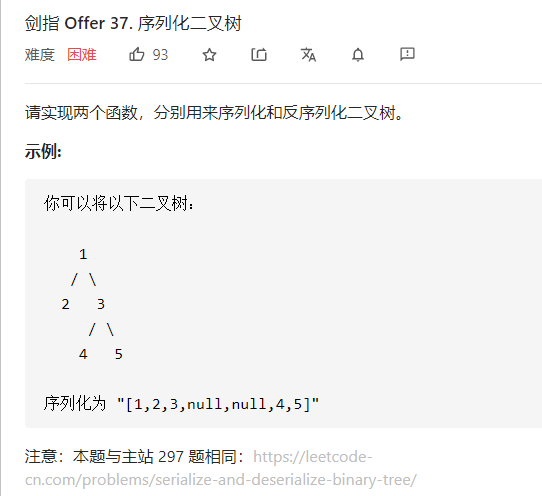剑指offer Leetcode 37.序列化二叉树
本文共 3610 字,大约阅读时间需要 12 分钟。

注意:序列化和反序列化只要能可逆就行,后面可以多出几个NULL
注意:string用+= 和push_back()效率要高于 用+,用+需要创建一个新的stirng对象
序列化:层序遍历
思想:
逐层写入
复杂度:
●时间:遍历每一个节点:O(n)
●空间:O(n),利用队列
代码:
// Encodes a tree to a single string. string serialize(TreeNode* root) { //询问面试官为空时是string是空还是有个NULL,为空则要加判root是否为空,为NULL则不用 queue my_queue; my_queue.push(root); string str_tree; //层序遍历 while(!my_queue.empty()){ TreeNode* cur = my_queue.front(); my_queue.pop(); //不为空则写入 if(cur != NULL){ str_tree += to_string(cur->val); str_tree += ","; my_queue.push(cur->left); my_queue.push(cur->right); } else str_tree += "NULL,"; } //去掉最后的逗号 str_tree.pop_back(); return str_tree; } 反序列化
思想:
将string中的每个节点分隔开并放入vector<TreeNode*>,并利用vector<TreeNode*>重建
复杂度:
这里获取单个字符串较为复杂,可以使用流的方式。
代码:
TreeNode* deserialize(string data) { if(data.size() == 0) return NULL; int size_data = data.size(); //i用来遍历data int i = 0; vector vec_tree; //将string转为vector 来存储 while(i < size_data){ string str_cur = ""; while(i < size_data && data[i] != ','){ str_cur.push_back(data[i]); i++; } if(str_cur == "NULL") vec_tree.push_back(NULL); else{ TreeNode* tmp = new TreeNode(stoi(str_cur)); vec_tree.push_back(tmp); } //跳过逗号 i++; } //画一下就能理解这个流程,i用来遍历父节点,j用来遍历子节点 for(int i = 0, j = 1; j < vec_tree.size(); i++){ if(vec_tree[i] == NULL) continue; //连接左子树 vec_tree[i]->left = vec_tree[j++]; //连接右子树,因为j加了1,所以需要判断 if(j < vec_tree.size()) vec_tree[i]->right = vec_tree[j++]; } return vec_tree[0]; } 利用流序列化和反序列化
注意:
这里是用空格间隔而不是用",",这样更方便获取str_cur,要用逗号序列化可以在反序列化时先把逗号转为空格
代码:
class Codec { public: // Encodes a tree to a single string. string serialize(TreeNode* root) { ostringstream out; queue my_queue; my_queue.push(root); while(!my_queue.empty()){ TreeNode* cur = my_queue.front(); my_queue.pop(); if(cur != NULL){ out< val<<" "; my_queue.push(cur->left); my_queue.push(cur->right); } else out<<"NULL "; } return out.str(); } // Decodes your encoded data to tree. TreeNode* deserialize(string data) { istringstream input(data); string str_cur; vector vec_node; //利用流来获取单个字符 while(input >> str_cur){ if(str_cur == "NULL") vec_node.push_back(NULL); else vec_node.push_back(new TreeNode(stoi(str_cur))); } // i每往后移动一位,j移动两位,j始终是当前i的左子下标 // 肯定是j先到达边界,所以这里判断j < vec.size() for (int i = 0, j = 1; j < vec_node.size(); ++i) { //某个NULL的下面一层还有别的节点时(类似于NULL为头节点),如[1,N,2,N,N,3,4]就需要这里的判断 if (vec_node[i] == NULL) continue; // 当前j位置为i的左子树 vec_node[i]->left = vec_node[j++]; // 当前j位置为i的右子树,j改变了,所以需要判断 if (j < vec_node.size()) vec_node[i]->right = vec_node[j++]; } return vec_node[0]; }}; 转载地址:http://mndq.baihongyu.com/
你可能感兴趣的文章
new 一个button 然后dispose,最后这个button是null吗???
查看>>
new一个对象的过程
查看>>
new对象时,JVM内部究竟藏了什么小秘密?
查看>>
Next.js React Server Components 教程
查看>>
NextGen Mirth Connect XStream反序列化远程代码执行漏洞(CVE-2023-43208)
查看>>
next项目部署到服务器pm2进程守护
查看>>
nexus 介绍
查看>>
nexus上传jar
查看>>
Nexus指南中的更新强调集成和透明度的重要性
查看>>
Nexus指南已经发布
查看>>
Nexus(1):Nexus的安装与配置
查看>>
NFinal学习笔记 02—NFinalBuild
查看>>
NFS
查看>>
nfs mount 故障 mount.nfs: access denied by server while mounting 10.0.100.208:/backup_usb
查看>>
NFS Server及Client配置与挂载详解
查看>>
NFS 服务配置篇
查看>>
NFS共享文件系统搭建
查看>>
nfs复习
查看>>
NFS安装配置
查看>>
NFS服务器配置-服务启动与停止
查看>>